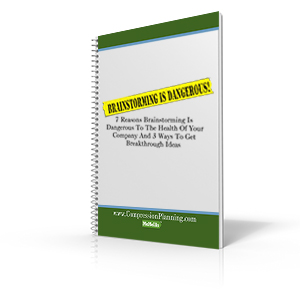Don’t call it Compression Planning® unless you plan to take Action!
One of the struggles we hear from some graduates of the Compression Planning® Institute is
We never seem to get past the FOCUS stage in the Master Planning Model. What can we do differently to make it through the entire model?”
Here are my top 12 suggestions to get you further in the model…specifically developing action steps!
Before you start a Compression Planning session, ensure you have true leadership behind resolving your issue or moving your opportunity forward!
1. Let participants know, as well as those they report to, that action is expected to be taken as a result of your planning session. You should never hear “now I can get back to work” at the end of a Compression Planning session because that is what is happening during it and as a result of it!
2. Revisit how you recruit your participants. Do they know what is being asked of them before they attend?
3. Examine the timing of your session. Some groups spend the majority of their time in the Exploration Phase and don’t leave enough time for focusing and action planning. I plan my time backwards on the Master Model. If I know I want to spend 20 minutes on an Action plan, I mark that, then another 20 for the Focus Phase that leaves the balance for orienting and exploring.
4. There are three basic types of Compression Planning groups.
- A group made up of “implementers” who will task the decisions they make.
- A group made up of “implementers” who will task the decisions once they get “sign off” from supervisor/executive team.
- A focus group – customers, clients, other departments, etc. They are charged with coming up with the ideas/recommendations which are then turned over to a team to implement or make decisions to implement.
You (and your participants) need to have clarity as to which group you have.
5. As a general rule of thumb, if you want to end with an Action Plan, take the amount of time you have with the group and divide it in half. If you are not done with exploration by “half time” you will never have enough time to develop an Action Plan.
6. Plan on spending 12-15 minutes per header while exploring. You can save time by subdividing and having smaller group take on a header…or several at once.
7. Design to the amount of time you have…or time your design and determine how much time you need. If you know you can have a group for 90 minutes, then plan accordingly. If you have a design that needs more time, determine how much you need and recruit to that amount of time.
 8. I sometimes post time references (i.e. little clocks with numbers representing minutes) to let the group know how much time we have to spend in a particular area. This lets the group monitor their own progress and they can kick it into high gear if they are falling behind.
8. I sometimes post time references (i.e. little clocks with numbers representing minutes) to let the group know how much time we have to spend in a particular area. This lets the group monitor their own progress and they can kick it into high gear if they are falling behind.
9. Use timers and ask a participant to be in charge of keeping track of time. My favorites are the ones from West Bend. You can get one here on Amazon. I also use it as a back up alarm clock while on the road or at home if there is a chance of a storm!
10. Make sure you are churning those ideas and developing rich, actionable ideas. These get people excited to see them implemented and frequently these ideas “recruit themselves” by having people volunteer to do them! Check out the following blogs on churning to get some ideas you may not have thought of before.
- “Why You Should Never Brainstorm“
- “Getting Your Ideas To Pop“
- “Laying The Foundation For Rich Ideas“
- “Developing Actionable Ideas“
11. You ALWAYS have a communication responsibility. If it is complex, use the template. It is located on page 94 of “The Compression Planning Advantage: A Blueprint for Resolving Complex Issues.” You can also view the “Wedding Model” I shared during the institute below. It is of a session using the Communications template.
If you have simple communications needs, embed them in your Action Plan. “Brief the Executive Team on XYZ” or “Let the Board of Trustees know we are putting together “Our Story” so they can use it for the upcoming capital campaign. It should be ready for them in 4 weeks.”
12. Debrief. Do it with the group or on your own. It is always helpful.
If you have any questions about any of the above, either drop me an email or post your question/observation in the comments section to this blog.
 P.S. – If you haven’t yet downloaded our Special Report “7 Reasons Brainstorming Is Dangerous To The Health Of Your Company & 3 Ways To Get Breakthrough Ideas,” I highly recommend it. We have received a ton of positive feedback and people say it has been very helpful in their facilitating the development of ideas.
P.S. – If you haven’t yet downloaded our Special Report “7 Reasons Brainstorming Is Dangerous To The Health Of Your Company & 3 Ways To Get Breakthrough Ideas,” I highly recommend it. We have received a ton of positive feedback and people say it has been very helpful in their facilitating the development of ideas.


No comments yet.